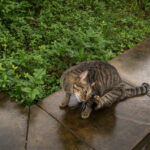Fruit flies, scientifically known as Drosophila melanogaster, are common household pests that often appear uninvited, especially when there’s ripe or decaying fruit around. Their name, “drosophila,” which means “lover of dew,” hints at their need for moisture to survive. With their constant presence in kitchens and pantries, a common question arises: Do Fruit Flies Bite Humans?
To answer this question and provide a comprehensive understanding of these tiny insects, let’s delve into their characteristics, behavior, and interactions with humans.
Understanding Fruit Flies: What Are They?
Fruit flies are small insects belonging to the fly family, but much smaller than houseflies.
What do fruit flies look like? Adult fruit flies are typically about 0.12 inches long and 0.08 inches wide. They possess a classic fly body shape, characterized by:
- Body Color: Tan to brownish-black bodies.
- Head: Rounded head with small antennae.
- Eyes: Three simple eyes and large, distinctive compound eyes that are usually red.
- Wings: A single pair of wings extending from the middle section of their abdomen.
Fruit Flies vs. Gnats: Often confused with gnats, fruit flies can be distinguished by their body shape and color. Gnats have thinner bodies and are generally darker, appearing black, whereas fruit flies have a more robust body and a lighter, tan to brown coloration.
What do fruit flies eat? Fruit flies are primarily attracted to and feed on fruits, especially overripe or fermenting ones. Their diet extends to other decaying organic matter, including rotting plants. Fruit fly larvae, upon hatching, rely entirely on the food source where they were laid. This feeding habit is a key reason why they are considered pests in homes, particularly kitchens.
The Question of Bites: Do Fruit Flies Bite Humans?
The straightforward answer to the question “do fruit flies bite humans?” is no, fruit flies do not bite humans.
Fruit flies lack the mouthparts necessary to pierce human skin and draw blood. Their mouthparts are designed for lapping up liquid food sources, like fermenting fruit juice or sugary spills. They are equipped with a proboscis, a sponge-like structure that allows them to soak up liquids.
While fruit flies might land on your skin, especially if you are near their food source, they are not interested in biting you. Any sensation you might feel is likely just the tickling of their tiny feet as they walk on your skin, not a bite.
Why the confusion? The confusion about fruit flies biting might stem from misidentification with other small flying insects that do bite, such as mosquitoes, gnats (some types), or even fleas. These insects have different mouthparts designed for piercing skin to feed on blood, which fruit flies simply do not possess.
Why Fruit Flies Are Pests (and Annoying)
Although fruit flies are not harmful in the sense of biting, they are undoubtedly pests due to several reasons:
- Attraction to Food: Their strong attraction to ripe, rotting, and fermenting fruits and vegetables, as well as other sugary substances like wine, beer, vinegar, and fruit juice, leads them to infest kitchens and food storage areas.
- Rapid Reproduction: Fruit flies have a very short life cycle and reproduce rapidly. A female fruit fly can lay hundreds of eggs near or on fermenting food sources. This rapid reproduction can quickly lead to large infestations.
- Contamination: Fruit flies can carry bacteria and pathogens from unsanitary environments to your food. While they are not known to transmit serious diseases, their presence is unhygienic and can potentially contaminate food, especially if they land on exposed food items.
Preventing and Managing Fruit Flies
To prevent fruit fly infestations and manage existing ones, focus on eliminating their food sources and breeding grounds:
- Remove Overripe Produce: Discard overripe or rotting fruits and vegetables promptly.
- Store Fruit Properly: Store ripe fruits in the refrigerator or in sealed containers.
- Clean Spills Immediately: Wipe up any spills of sugary liquids, juice, wine, or vinegar immediately.
- Empty Trash Regularly: Empty kitchen trash cans frequently, especially those containing food waste.
- Clean Drains: Fruit flies can breed in drains with accumulated organic matter. Clean drains regularly.
- Use Fruit Fly Traps: Simple traps can be made using apple cider vinegar in a dish covered with plastic wrap with small holes, or commercially available fruit fly traps can be used.
Conclusion
In conclusion, fruit flies are nuisance pests that can be a source of frustration in homes, but they do not bite humans. Their mouthparts are designed for lapping liquids, not piercing skin. Focusing on good sanitation and eliminating their food sources is the most effective way to prevent and manage fruit fly infestations, ensuring a pest-free and hygienic environment. While they may be annoying, you can rest assured that fruit flies are not a biting threat to you or your family.
